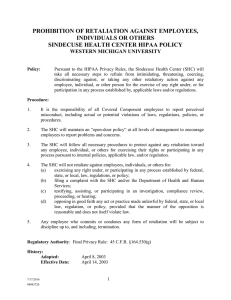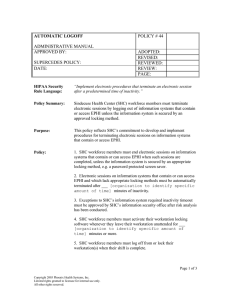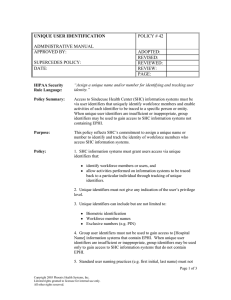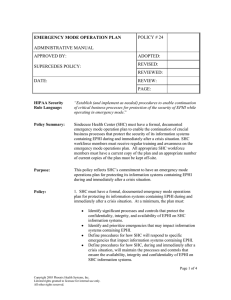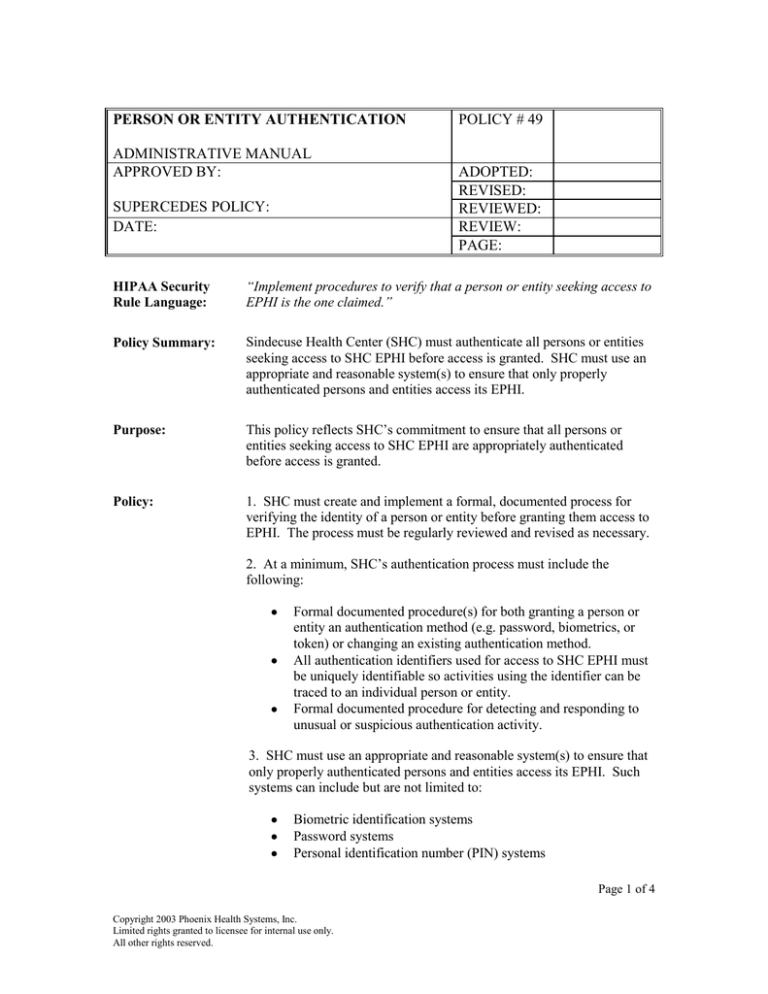
PERSON OR ENTITY AUTHENTICATION
ADMINISTRATIVE MANUAL
APPROVED BY:
SUPERCEDES POLICY:
DATE:
POLICY # 49
ADOPTED:
REVISED:
REVIEWED:
REVIEW:
PAGE:
HIPAA Security
Rule Language:
“Implement procedures to verify that a person or entity seeking access to
EPHI is the one claimed.”
Policy Summary:
Sindecuse Health Center (SHC) must authenticate all persons or entities
seeking access to SHC EPHI before access is granted. SHC must use an
appropriate and reasonable system(s) to ensure that only properly
authenticated persons and entities access its EPHI.
Purpose:
This policy reflects SHC’s commitment to ensure that all persons or
entities seeking access to SHC EPHI are appropriately authenticated
before access is granted.
Policy:
1. SHC must create and implement a formal, documented process for
verifying the identity of a person or entity before granting them access to
EPHI. The process must be regularly reviewed and revised as necessary.
2. At a minimum, SHC’s authentication process must include the
following:
Formal documented procedure(s) for both granting a person or
entity an authentication method (e.g. password, biometrics, or
token) or changing an existing authentication method.
All authentication identifiers used for access to SHC EPHI must
be uniquely identifiable so activities using the identifier can be
traced to an individual person or entity.
Formal documented procedure for detecting and responding to
unusual or suspicious authentication activity.
3. SHC must use an appropriate and reasonable system(s) to ensure that
only properly authenticated persons and entities access its EPHI. Such
systems can include but are not limited to:
Biometric identification systems
Password systems
Personal identification number (PIN) systems
Page 1 of 4
Copyright 2003 Phoenix Health Systems, Inc.
Limited rights granted to licensee for internal use only.
All other rights reserved.
PERSON OR ENTITY AUTHENTICATION
Telephone callback systems
Security token systems
4. When applicable, such authentication system(s) must include, at a
minimum:
Unique user identifiers (user IDs) that enable persons and
entities to be uniquely identified. User IDs must not give any
indication of the user’s privilege level. Group identifiers must
only be used when unique user identifiers are insufficient or
inappropriate. Group identifiers must be reviewed and approved
by appropriate management. Group identifiers must not be used
to gain access to SHC information systems containing EPHI.
A secret identifier (password)
The prompt removal or disabling of authentication methods for
persons and entities that no longer need access to SHC EPHI.
Verification that redundant user identifiers are not issued.
5. All authentication methods must meet the defined standard(s) of the
SHC Information Security Office. The Information Security Office must
provide SHC employees with regular training and awareness about the
authentication standard(s).
6. All authentication data, such as passwords and PINs, must be
protected with appropriate access controls to prevent unauthorized access.
7. All password and PIN based authentication systems on SHC
information systems must mask, suppress, or otherwise obscure the
passwords and PINs so that unauthorized persons are not able to observe
them.
8. Methods (e.g. password or PIN) for authentication to SHC information
systems must not be built into logon scripts. All exceptions must be
reviewed and approved by appropriate management.
9. SHC employees must not share or reveal their authentication methods
to others. Sharing an authentication method means the authorized user
assumes responsibility for actions that another party takes with the
disclosed method. A SHC employee who believes that their
authentication method is being inappropriately used must immediately
notify his or her manager.
10. SHC employees must immediately report the loss or theft of an
access method (e.g. key card or security token) to appropriate
management.
11. To prevent authentication by unauthorized persons, SHC employees
must activate their workstation locking software whenever they leave
their workstation unattended. Locking or timeout software must activate
Page 2 of 4
Copyright 2003 Phoenix Health Systems, Inc.
Limited rights granted to licensee for internal use only.
All other rights reserved.
PERSON OR ENTITY AUTHENTICATION
on all SHC information systems after 3 (three) minutes or more of
inactivity.
12. Authentication attempts to all SHC information systems must be
limited to no more than 5 attempts in 60 minutes. Authentication
attempts that exceed the limit must result in:
The relevant account being disabled for an appropriate period of
time;
The event being logged; and
Notification of appropriate personnel.
Scope/Applicability: This policy is applicable to all departments that use or disclose electronic
protected health information for any purposes.
This policy’s scope includes all electronic protected health information,
as described in Definitions below.
Regulatory
Category:
Technical Safeguards
Regulatory Type:
Standard
Regulatory
Reference:
45 CFR 164.312(d)
Definitions:
Electronic protected health information means individually identifiable
health information that is:
Transmitted by electronic media
Maintained in electronic media
Electronic media means:
(1) Electronic storage media including memory devices in computers
(hard drives) and any removable/transportable digital memory medium,
such as magnetic tape or disk, optical disk, or digital memory card; or
(2) Transmission media used to exchange information already in
electronic storage media. Transmission media include, for example, the
internet (wide-open), extranet (using internet technology to link a
business with information accessible only to collaborating parties), leased
lines, dial-up lines, private networks, and the physical movement of
removable/transportable electronic storage media. Certain transmissions,
including of paper, via facsimile, and of voice, via telephone, are not
considered to be transmissions via electronic media, because the
Page 3 of 4
Copyright 2003 Phoenix Health Systems, Inc.
Limited rights granted to licensee for internal use only.
All other rights reserved.
PERSON OR ENTITY AUTHENTICATION
information being exchanged did not exist in electronic form before the
transmission.
Information system means an interconnected set of information resources
under the same direct management control that shares common
functionality. A system normally includes hardware, software,
information, data, applications, communications, and people.
Authentication means the corroboration that a person or entity is the one
claimed.
Biometric identification system means a system in which a person can be
uniquely identified by evaluating one or more distinguishing biological
traits. Unique identifiers include fingerprints, hand geometry, earlobe
geometry, retina and iris patterns, voice waves, DNA, and signatures.
A security token system means a system in which a small hardware device
along with a secret code (e.g. password or PIN) is used to authorize
access to an information system.
Responsible
Department:
Information Systems
Policy Authority/
Enforcement:
SHC’s Security Official is responsible for monitoring and enforcement of
this policy, in accordance with Procedure #(TBD).
Related Policies:
Password Use and Management
Log-in Monitoring
Security Awareness and Training
Renewal/Review:
This policy is to be reviewed annually to determine if the policy complies
with current HIPAA Security regulations. In the event that significant
related regulatory changes occur, the policy will be reviewed and updated
as needed.
Procedures:
TBD
Page 4 of 4
Copyright 2003 Phoenix Health Systems, Inc.
Limited rights granted to licensee for internal use only.
All other rights reserved.

